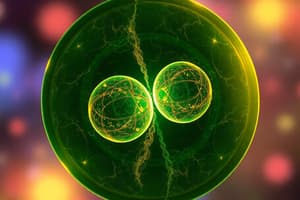Podcast
Questions and Answers
What is the main function of the spindle apparatus during mitosis?
What is the main function of the spindle apparatus during mitosis?
- To separate duplicated chromosomes (correct)
- To condense chromosomes
- To align chromosomes at the metaphase plate
- To break down the nuclear envelope
Which phase of mitosis is characterized by the alignment of chromosomes at the metaphase plate?
Which phase of mitosis is characterized by the alignment of chromosomes at the metaphase plate?
- Metaphase (correct)
- Anaphase
- Prophase
- Prometaphase
What happens during prometaphase in mitosis?
What happens during prometaphase in mitosis?
- Centromeres attach to spindle fibers (correct)
- Chromosomes align at the metaphase plate
- Chromosomes condense and become visible
- Nuclear envelope breaks down
Why are sister chromatids referred to as chromosomes in prometaphase?
Why are sister chromatids referred to as chromosomes in prometaphase?
Which phase of mitosis is characterized by the disappearance of the nucleolus and movement of nuclear material towards the cell center?
Which phase of mitosis is characterized by the disappearance of the nucleolus and movement of nuclear material towards the cell center?
What happens during telophase of mitosis?
What happens during telophase of mitosis?
How does anaphase contribute to cell division?
How does anaphase contribute to cell division?
Which phase ensures that each daughter cell receives one set of chromosomes equal to the parent cell's genetic makeup?
Which phase ensures that each daughter cell receives one set of chromosomes equal to the parent cell's genetic makeup?
What is a key difference between mitosis and meiosis?
What is a key difference between mitosis and meiosis?
In which process does crossing over occur?
In which process does crossing over occur?
Flashcards are hidden until you start studying
Study Notes
Mitosis: Understanding the Process of Cell Division
Mitosis is a fundamental process in biology, essential for the growth and reproduction of all living organisms. It's a type of cell division that results in two genetically identical daughter cells from one parent cell. This process allows cells to divide without losing genetic information. In this section, we will explore the phases of mitosis, their functions, and what they contribute to cell division.
Phases of Mitosis
Mitosis consists of five distinct stages: prophase, prometaphase, metaphase, anaphase, and telophase. Each phase has its own set of functions that contribute to the overall process. Here is a brief overview of each phase:
Prophase: During this stage, the chromosomes condense and become visible under a microscope. Nuclear material starts moving towards the center of the cell, and the nucleolus disappears. The spindle apparatus forms, which consists of microtubules that play a crucial role in separating the duplicated chromosomes later during mitosis.
Prometaphase: As the nuclear envelope breaks down, the spindle fibers attach to the centromeres of sister chromatids. These chromatids are now referred to as chromosomes due to their condensed state. The two identical chromatids, or sister chromatids, line up along the equatorial plane of the dividing cell.
Metaphase: At this point, all chromosomes align themselves at the metaphase plate of the middle of the cell. This ensures that when the cell divides, each daughter cell will receive one set of chromosomes equal to the parent cell's genetic makeup.
Anaphase: The spindle fibers shorten and pull apart the sister chromatids towards opposite poles of the cell. This separates the duplicated DNA into two identical sets, ensuring that the two resulting cells will have an equal number of chromosomes.
Telophase: In this last stage, the nucleoli start forming again, and new nuclear envelopes are formed around the separated groups of chromosomes. Finally, the spindle apparatus begins breaking down while the cytoplasm starts pinching off to separate the two newly formed nuclei from each other.
Mitosis vs Meiosis
While mitosis is crucial for growth and repair, meiosis is responsible for producing gametes with half the genetic material of the parent cell, allowing for sexual reproduction. Although both processes involve cell division, they differ significantly in their function and end result. Here is a summary of these differences:
| Feature | Mitosis | Meiosis |
|---|---|---|
| Cell Type | Somatic Cell | Germ Cell |
| End Result | Two genetically identical daughter cells | Four genetically unique gametes |
| Process Length | 1-2 hours | Several days |
| DNA Content | 46 chromosomes | 23 chromosomes |
| Chromosome Number | 46 chromosomes | 23 chromosomes |
| Chromosome Pairing | No | Yes, crossing over occurs |
| Sexual Reproduction | Not directly involved | Directly involved as part of reproduction |
Applications and Importance
Mitosis is essential for the growth and repair of multicellular organisms. It allows for the production of genetically identical daughter cells, which is crucial for maintaining the stability of an organism's genetic makeup. In addition, mitosis plays a role in the development of embryos, tissue repair, and the cloning of certain organisms.
In summary, mitosis is a fundamental process in biology that allows for the growth and repair of cells, as well as the production of genetically identical daughter cells. Understanding the phases of mitosis and their functions can help in grasping the importance of mitosis in cell division and its role in maintaining the genetic integrity of organisms.
Studying That Suits You
Use AI to generate personalized quizzes and flashcards to suit your learning preferences.




